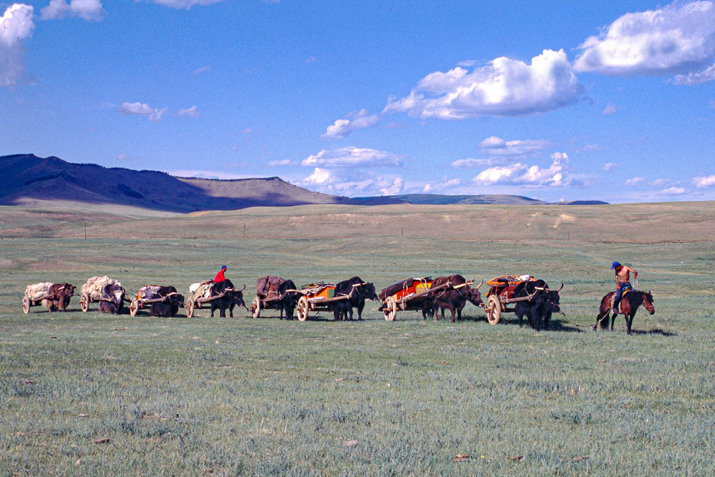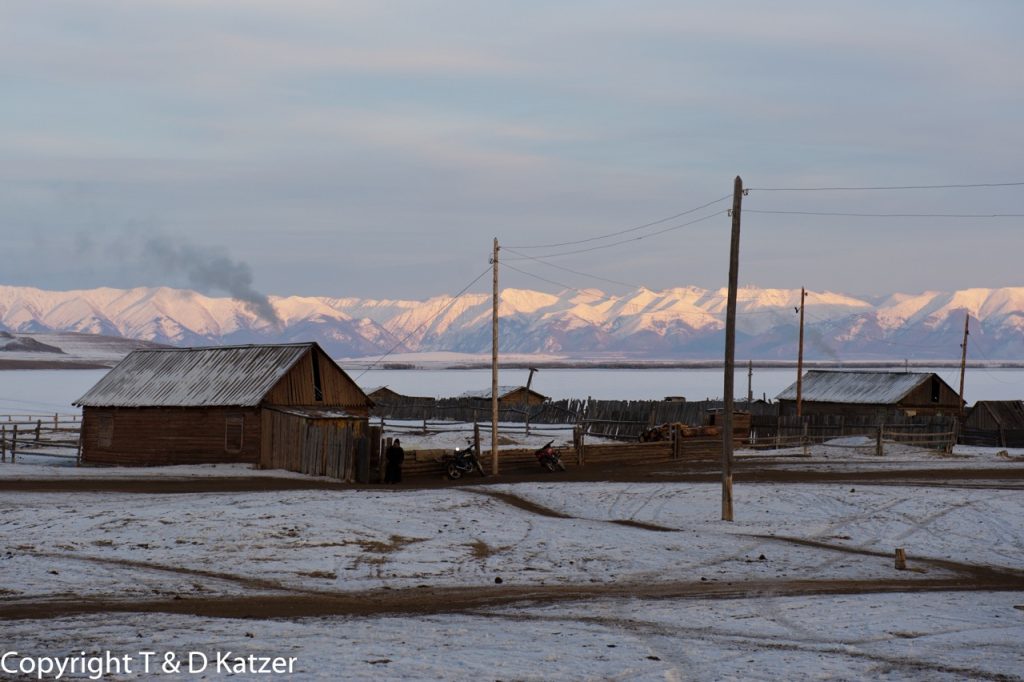
Two mayors don’t make it easy for us
N 51°21'785'' E 099°21'046''
Day: 114
Sunrise:
08:39
Sunset:
17:35
Total kilometers:
1146
Soil condition:
Ice, snow
Temperature – Day (maximum):
minus 13°C
Temperature – day (minimum):
minus 18°C
Temperature – Night:
minus 27°C
Latitude:
51°21’785”
Longitude:
099°21’046”
Maximum height:
1475 m above sea level


Today we have an appointment with the mayor of Tsagaan Nuur. Although I am not quite sure why we are supposed to visit them, we set off to walk to the wooden government building. Again we climb the wooden steps to the second floor. We walk down a long corridor, past some blue-painted doors behind which the local officials sit. Firewood is neatly stacked at each end of the corridor. It looks like a woman is responsible for keeping each of the ovens in the offices running so that it is pleasantly warm.
“Have a seat,” a 50-year-old Mongolian woman dressed in modern clothes offers us to sit down at the small meeting table in front of her desk. A few minutes of awkward silence pass as another woman enters the room. “Have a wonderful day,” she says in good English. “Oh, you speak good English,” I praise her for the moment, relieved to be able to communicate with the mayor through her. “I am the mayor of Tsataan,” she introduces herself. Surprised to now have two mayors in front of us, we explain after the usual polite phrases why we are here. “Oh, you want to join my people? Hm, that’s nice. And you’re writing a book? That’s fantastic. I’m also writing a book about my people. I’m trying to record the old rites and songs. Unfortunately, I don’t have the financial means to publish it at the moment,” she explains, rambling and very friendly. “Maybe a little too friendly,” I think to myself. When we tell them about Saraa and her NGO, the two women know nothing about it. I immediately call Saraa and hand the mayor my cell phone. She furrows her brow and speaks a few words to her until the line breaks down. After the third attempt, she gives up and shows no further interest in talking to Saraa. “You know, there are a lot of NGOs here,” she says in a tone that allows slight skepticism to permeate. We then show her our letter of recommendation from the mayor’s office in Mörön. The two ladies read it and hand it back to us without comment. I have no idea whether this letter has made an impression, because there is no sign of emotion on their faces.
“You can’t stay in a yurt with the Tsataan. I will not tolerate that. It could make the Tsataan only want to live in yurts in the future. That is against our culture. The only way to spend time there is in a tipi,” the Tsataan representative’s statement startles me. “Well, as far as I’ve heard, some of your people already live in log cabins?” I ask. “Yes, that’s right.” “Yurt tents are thousands of years old and are the traditional dwelling of the Turkic and Mongolian-speaking steppe nomads of Eurasia. They have continued to be developed to this day. Later, the yurt shape was also built in wood. Then the round shape was completely abandoned and people lived in log huts. This means that the log huts are still many steps closer to modern civilization than a yurt. So why are you against a yurt?” I ask kindly. “Because I don’t want my people to live in yurts in the future,” she repeats herself word for word, also smiling kindly.
The Tsataan are still nomadic thanks to their reindeer. They use their reindeer to transport their tipis from pasture to pasture over very difficult, inaccessible mountain terrain. The cone-shaped pole tent is very light compared to a yurt and can therefore be loaded onto reindeer. The weight of a yurt alone would make it impossible to find a new grazing area. At this point you might ask yourself why we don’t want to live in a tipi? Would be even more original. There are two reasons for this. On the one hand, the yurt is the traditional Mongolian dwelling. If you decide to live in it, you have to buy and organize all the furnishings for it. Because of the completely different construction method and because a tipi is much smaller, the yurt furnishings only fit into a tipi to a limited extent. So we would have to buy or rent a tipi in addition to the yurt we have been living in for many weeks. Plus the purchase of one or two furnishings. That is simply too expensive. On the other hand, it is much colder in a tipi than in a yurt because of its high shape. Keeping the heat in is more difficult. With the forecast permafrost of minus 40 °C to minus 50 °C, a yurt is more comfortable, more spacious, cozier and, above all, warmer.
Shortly afterwards, we learn that two years ago, the Mongolian government gave every Tsataan family a yurt. Strange. First you give people a yurt and then they are not allowed to set it up? Something is wrong. And that’s exactly what we find out a little later. The Tsataan word representative is controversial. Many people don’t like them. Since some of the statements are so condemning, I don’t want to mention them here. Among other things, she is said to be working as mayor to make money and less to represent the interests of her people. In fact, she has a guest house and a store and is apparently in the tourist business. Tipis are also often rented out to tourists. Maybe that’s another reason to want to make money with us. However, the conversation with the two ladies is not very satisfactory.
“What, you want to spend the whole winter with the Tsataans? That’s impossible. Ten days maximum. Then they have to leave,” says the mayor. “But why?” I ask kindly. “The Tsataan will take advantage of them and demand a lot of money. I have to go to them first and talk to them. I’m happy to do that for them,” she says. “Write well about us. We’ll do our best to help you,” the two politicians chat amiably and shake our hands at the end.
We leave the old wooden house and walk back to our yurt. Although Mother Earth has taught me that everything that happens is right, I am quite crestfallen at this moment. Was it in vain to have gone to such immense lengths to organize wintering with the Tsataan? At the moment, it is not the Tsataan who are putting a spoke in our wheel, but their representatives. The reasons for this are more than flimsy. But what should we do now?
In the evening I call Saraa. “Don’t worry about her statement. She is known for wanting to make money. Apart from that, around 90 % of all Tsataan live in Tsagaan Nuur in winter. They live in log cabins and yurts. So of course they have known yurts for a very long time,” she explains. “I thought the Tsataan lived in the taiga?” I wonder. “Only a small proportion of them spend the entire winter outside with the reindeer. Most of the women and all the children, on the other hand, are in Tsagaan Nuur.” “Why?” “Because the children have to go to school every day. During the summer vacations, however, all the family members move to the taiga,” explains Saraa. “I’ll call Dalai, Shagai’s wife, in a minute,” she says reassuringly. As Shagai is our link to the Tsataan and we live in his yurt, which we have rented through Saraa, we expect him to provide us with the necessary support.
“This is my yurt where you live. I was given it as a gift by the government and can put it up wherever and whenever I want. We live in a free country,” says Shagai, annoyed at his representative.
“It’s best if you call Tsaya. She lives in the taiga. Maybe you’ll have a chance to meet her,” Saraa suggests during the course of the evening’s discussions. I immediately dial Tsaya’s phone number and am delighted when she picks up. “Hello Tsaya. We are Saraa’s friends. You brought us the parcel yesterday,” I explain. “Yes, yes, of course I remember,” she replies very kindly. “Is it possible to meet you? Tanja and I would like to talk to you.” “Sure. When are you free?” “We always have time. When will you be back in Tsagaan Nuur?” “Tomorrow. If you want, we can meet at the Tuwa information center,” she suggests. “Great. When should we be there?” “From 1 p.m.” “We look forward to it,” I reply and end the call.
We look forward to your comments!

